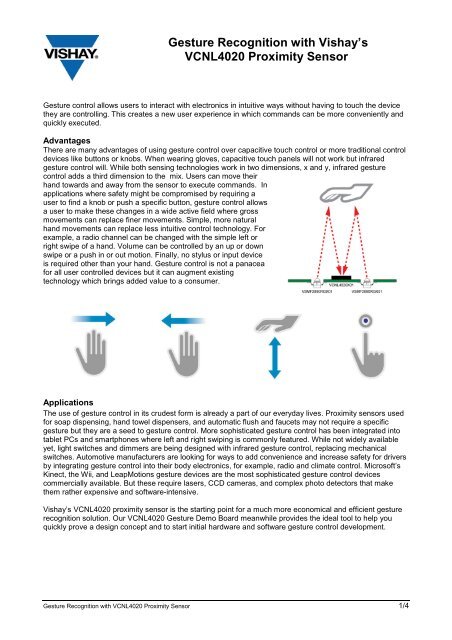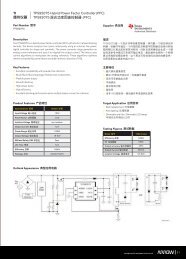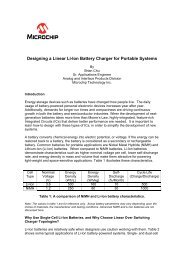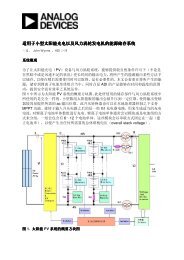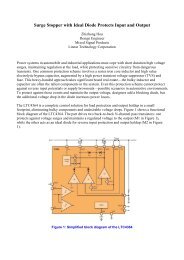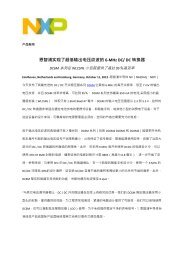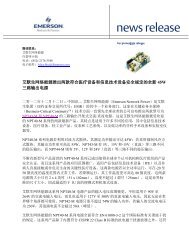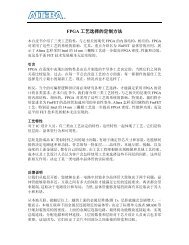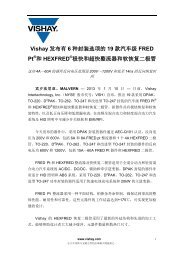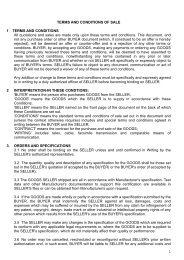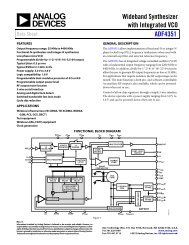Gesture Recognition with Vishay's VCNL4020 ... - Arrow Electronics
Gesture Recognition with Vishay's VCNL4020 ... - Arrow Electronics
Gesture Recognition with Vishay's VCNL4020 ... - Arrow Electronics
You also want an ePaper? Increase the reach of your titles
YUMPU automatically turns print PDFs into web optimized ePapers that Google loves.
<strong>Gesture</strong> <strong>Recognition</strong> <strong>with</strong> Vishay’s<strong>VCNL4020</strong> Proximity Sensor<strong>Gesture</strong> control allows users to interact <strong>with</strong> electronics in intuitive ways <strong>with</strong>out having to touch the devicethey are controlling. This creates a new user experience in which commands can be more conveniently andquickly executed.AdvantagesThere are many advantages of using gesture control over capacitive touch control or more traditional controldevices like buttons or knobs. When wearing gloves, capacitive touch panels will not work but infraredgesture control will. While both sensing technologies work in two dimensions, x and y, infrared gesturecontrol adds a third dimension to the mix. Users can move theirhand towards and away from the sensor to execute commands. Inapplications where safety might be compromised by requiring auser to find a knob or push a specific button, gesture control allowsa user to make these changes in a wide active field where grossmovements can replace finer movements. Simple, more naturalhand movements can replace less intuitive control technology. Forexample, a radio channel can be changed <strong>with</strong> the simple left orright swipe of a hand. Volume can be controlled by an up or downswipe or a push in or out motion. Finally, no stylus or input deviceis required other than your hand. <strong>Gesture</strong> control is not a panaceafor all user controlled devices but it can augment existingtechnology which brings added value to a consumer.ApplicationsThe use of gesture control in its crudest form is already a part of our everyday lives. Proximity sensors usedfor soap dispensing, hand towel dispensers, and automatic flush and faucets may not require a specificgesture but they are a seed to gesture control. More sophisticated gesture control has been integrated intotablet PCs and smartphones where left and right swiping is commonly featured. While not widely availableyet, light switches and dimmers are being designed <strong>with</strong> infrared gesture control, replacing mechanicalswitches. Automotive manufacturers are looking for ways to add convenience and increase safety for driversby integrating gesture control into their body electronics, for example, radio and climate control. Microsoft’sKinect, the Wii, and LeapMotions gesture devices are the most sophisticated gesture control devicescommercially available. But these require lasers, CCD cameras, and complex photo detectors that makethem rather expensive and software-intensive.Vishay’s <strong>VCNL4020</strong> proximity sensor is the starting point for a much more economical and efficient gesturerecognition solution. Our <strong>VCNL4020</strong> <strong>Gesture</strong> Demo Board meanwhile provides the ideal tool to help youquickly prove a design concept and to start initial hardware and software gesture control development.<strong>Gesture</strong> <strong>Recognition</strong> <strong>with</strong> <strong>VCNL4020</strong> Proximity Sensor 1/4
<strong>Gesture</strong> <strong>Recognition</strong> <strong>with</strong> Vishay’s<strong>VCNL4020</strong> Proximity SensorDemo BoardThe foundation of Vishay’s <strong>Gesture</strong> Demo board is the <strong>VCNL4020</strong> proximity and ambient light sensor. Twoof Vishay’s SurfLight VSMF2890RGX01 infrared diodes are mounted on either side of the sensor at adistance of approximately 20 mm. The reverse gullwing package of these diodes plays a key role in thegesture application. They are mounted on the opposite side of the PCB from the <strong>VCNL4020</strong> sensor whichminimizes cross talk between the diodes and the sensor. A high radiant intensity of typically 80 mW/sr at200 mA allows for the detection of hand gestures up to 20 cm above the demo board.Principle of OperationThe detection of gestures using the <strong>Gesture</strong> Demo Boardis accomplished by comparing the signal of infrared lightcoming from each of the emitters. The emitted infraredlight is reflected from an object (a hand, for example) andis then detected by the <strong>VCNL4020</strong> proximity sensor. Todistinguish between the signals coming from the twoemitters, the emitters are multiplexed, meaning they arepulsed one after the other in quick succession.The proximity signal is then read out between each pulsevia the I 2 C bus interface. When a hand is in the proximityof the board, it will reflect more signal from the emitter itis directly located over. If the hand is then moved acrossthe board, the signal from one emitter will increase beforethe other. It is this time difference of signal strength thatis analyzed to determine if a swipe gesture was madeand in which direction.<strong>Gesture</strong> <strong>Recognition</strong> <strong>with</strong> <strong>VCNL4020</strong> Proximity Sensor 2/4
<strong>Gesture</strong> <strong>Recognition</strong> <strong>with</strong> Vishay’s<strong>VCNL4020</strong> Proximity Sensor<strong>Gesture</strong> <strong>Recognition</strong>The detection of a gesture is composed of two main parts. The acquisition and preparation of the raw data tobe analyzed and the detection algorithm that is able to interpret this raw data correctly. If a gesture isrecognized, a corresponding event is triggered.The data used for gesture recognition is acquired in separate data streams, one per emitter. As the emittersare multiplexed, and only one emitter should be on at a time, the measurements occur slightly after oneanother. One measurement cycle consists of a set of data from each channel.The measurements are done in quick succession so that compared to the time taken to complete one fullmeasurement cycle, the time between the individual proximity measurements per IRED is negligible. In thisway the signals can be compared <strong>with</strong> one another in close to real time.To be able to analyze and compare the data streams of each emitter channel <strong>with</strong> one another, the data ofeach stream is split into frames of “n” measurements. Here, each frame contains the latest “n”measurements, <strong>with</strong> each iteration of the measurement cycle, moving the frame over by one. Therecognition algorithm analyzes each frame and once a frame is seen to contain a gesture, the next fewframes are ignored, in order to avoid detecting the same gesture twice. Furthermore, by ignoring severalframes after a valid gesture has been detected, false positives from hand movement in front of the sensorfield of view which are not intended as a gesture is reduced.<strong>Gesture</strong> <strong>Recognition</strong> <strong>with</strong> <strong>VCNL4020</strong> Proximity Sensor 3/4
<strong>Gesture</strong> <strong>Recognition</strong> <strong>with</strong> Vishay’s<strong>VCNL4020</strong> Proximity SensorThe gesture board comes <strong>with</strong> demo software that implements the detection algorithm and visualizes thedetection of gestures. The software allows the key parameters of both the data acquisition and the detectionalgorithm to be changed. The affect these changes have on the system can then be tested immediately.The gesture demo board is an add-on board to the VCNL4000 Demo kit. More information about this demokit can be found at http://www.vishay.com/docs/83395/vcnl4000_demo_kit.pdf. Once you have purchased aVCNL4000 demo kit please contact sensorstechsupport@vishay.com if you wish to receive a gesture demoboard.<strong>Gesture</strong> <strong>Recognition</strong> <strong>with</strong> <strong>VCNL4020</strong> Proximity Sensor 4/4


